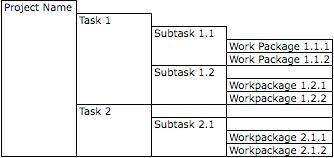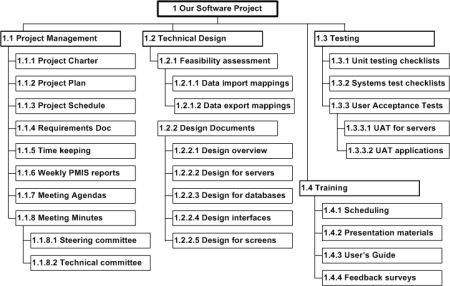Introduction
Dividing complex projects to simpler and manageable tasks is the process identified as Work Breakdown Structure (WBS). Usually, the project managers use this method for simplifying the
project execution. In WBS, much larger tasks are broken down to
manageable chunks of work. These chunks can be easily supervised and
estimated. WBS is not restricted to a specific field when it comes to
application. This methodology can be used for any type of project
management.
Following are a few reasons for creating a WBS in a project:
- Accurate and readable project organization.
- Accurate assignment of responsibilities to the project team.
- Indicates the project milestones and control points.
- Helps to estimate the cost, time and risk.
- Illustrate the project scope, so the stakeholders can have a better understanding of the same.
Construction of a WBS
Identifying the main deliverables of a project is the starting point for deriving a work breakdown structure. This important step is usually done by the project managers and the
subject matter experts (SMEs) involved in the project. Once this step is
completed, the subject matter experts start breaking down the
high-level tasks into smaller chunks of work. In the process of breaking down the tasks, one can break them down
into different levels of detail. One can detail a high-level task into
ten sub-tasks while another can detail the same high-level task into 20
sub-tasks. Therefore, there is no hard and fast rule on how you should breakdown
a task in WBS. Rather, the level of breakdown is a matter of the
project type and the management style followed for the project. In general, there are a few "rules" used for determining the smallest
task chunk. In "two weeks" rule, nothing is broken down smaller than
two weeks worth of work.
This means, the smallest task of the WBS is at least two-week long.
8/80 is another rule used when creating a WBS. This rule implies that no
task should be smaller than 8 hours of work and should not be larger
than 80 hours of work. One can use many forms to display their WBS. Some use tree structure
to illustrate the WBS, while others use lists and tables. Outlining is
one of the easiest ways of representing a WBS.
Following example is an outlined WBS:
There are many design goals for WBS. Some important goals are as follows:
- Giving visibility to important work efforts.
- Giving visibility to risky work efforts.
- Illustrate the correlation between the activities and deliverables.
- Show clear ownership by task leaders.
WBS Diagram
In a WBS diagram, the project scope is graphically expressed. Usually
the diagram starts with a graphic object or a box at the top, which
represents the entire project. Then, there are sub-components under the
box. These boxes represent the deliverables of the project. Under each
deliverable, there are sub-elements listed. These sub-elements are the
activities that should be performed in order to achieve the
deliverables. Although most of the WBS diagrams are designed based on the
deliveries, some WBS are created based on the project phases. Usually,
information technology projects are perfectly fit into WBS model.
Therefore, almost all information technology projects make use of WBS. In addition to the general use of WBS, there is specific objective
for deriving a WBS as well. WBS is the input for Gantt charts, a tool
that is used for project management purpose. Gantt chart is used for tracking the progression of the tasks derived by WBS.
Following is a sample WBS diagram:
Conclusion
The efficiency of a work breakdown structure can determine the success of a project. The WBS provides the foundation for all project management work,
including, planning, cost and effort estimation, resource allocation,
and scheduling. Therefore, one should take creating WBS as a critical step in the process of project management.

